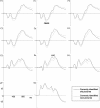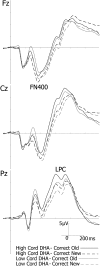Neurophysiologic and neurobehavioral evidence of beneficial effects of prenatal omega-3 fatty acid intake on memory function at school age
- PMID: 21389181
- PMCID: PMC3076654
- DOI: 10.3945/ajcn.110.000323
Neurophysiologic and neurobehavioral evidence of beneficial effects of prenatal omega-3 fatty acid intake on memory function at school age
Abstract
Background: The beneficial effects of prenatal and early postnatal intakes of omega-3 (n-3) polyunsaturated fatty acids (PUFAs) on cognitive development during infancy are well recognized. However, few studies have examined the extent to which these benefits continue to be evident in childhood.
Objective: The aim of this study was to examine the relation of n-3 PUFAs and seafood-contaminant intake with memory function in school-age children from a fish-eating community.
Design: In a prospective, longitudinal study in Arctic Quebec, we assessed Inuit children (n = 154; mean age: 11.3 y) by using a continuous visual recognition task to measure 2 event-related potential components related to recognition memory processing: the FN400 and the late positive component (LPC). Children were also examined by using 2 well-established neurobehavioral assessments of memory: the Digit span forward from Wechsler Intelligence Scales for Children, 4th edition, and the California Verbal Learning Test-Children's Version.
Results: Repeated-measures analyses of variance revealed that children with higher cord plasma concentrations of docosahexaenoic acid (DHA), which is an important n-3 PUFA, had a shorter FN400 latency and a larger LPC amplitude; and higher plasma DHA concentrations at the time of testing were associated with increased FN400 amplitude. Cord DHA-related effects were observed regardless of seafood-contaminant amounts. Multiple regression analyses also showed positive associations between cord DHA concentrations and performance on neurobehavioral assessments of memory.
Conclusion: To our knowledge, this study provides the first neurophysiologic and neurobehavioral evidence of long-term beneficial effects of n-3 PUFA intake in utero on memory function in school-age children.
Figures






Similar articles
-
Exposure to organochlorines and mercury through fish and marine mammal consumption: associations with growth and duration of gestation among Inuit newborns.Environ Int. 2013 Apr;54:85-91. doi: 10.1016/j.envint.2013.01.013. Epub 2013 Feb 17. Environ Int. 2013. PMID: 23422685 Free PMC article.
-
Prenatal exposure to methyl mercury from fish consumption and polyunsaturated fatty acids: associations with child development at 20 mo of age in an observational study in the Republic of Seychelles.Am J Clin Nutr. 2015 Mar;101(3):530-7. doi: 10.3945/ajcn.114.100503. Epub 2015 Jan 21. Am J Clin Nutr. 2015. PMID: 25733638 Free PMC article.
-
Beneficial effects of a polyunsaturated fatty acid on infant development: evidence from the inuit of arctic Quebec.J Pediatr. 2008 Mar;152(3):356-64. doi: 10.1016/j.jpeds.2007.07.008. Epub 2007 Oct 22. J Pediatr. 2008. PMID: 18280840
-
Can Early Omega-3 Fatty Acid Exposure Reduce Risk of Childhood Allergic Disease?Nutrients. 2017 Jul 21;9(7):784. doi: 10.3390/nu9070784. Nutrients. 2017. PMID: 28754005 Free PMC article. Review.
-
Long-chain omega-3 fatty acid supply in pregnancy and lactation.Curr Opin Clin Nutr Metab Care. 2008 May;11(3):297-302. doi: 10.1097/MCO.0b013e3282f795e6. Curr Opin Clin Nutr Metab Care. 2008. PMID: 18403927 Review.
Cited by
-
Benefits of docosahexaenoic acid, folic acid, vitamin D and iodine on foetal and infant brain development and function following maternal supplementation during pregnancy and lactation.Nutrients. 2012 Jul;4(7):799-840. doi: 10.3390/nu4070799. Epub 2012 Jul 24. Nutrients. 2012. PMID: 22852064 Free PMC article. Review.
-
The relationship of docosahexaenoic acid (DHA) with learning and behavior in healthy children: a review.Nutrients. 2013 Jul 19;5(7):2777-810. doi: 10.3390/nu5072777. Nutrients. 2013. PMID: 23877090 Free PMC article. Review.
-
Maternal PUFA status but not prenatal methylmercury exposure is associated with children's language functions at age five years in the Seychelles.J Nutr. 2012 Nov;142(11):1943-9. doi: 10.3945/jn.112.163493. Epub 2012 Sep 26. J Nutr. 2012. PMID: 23014496 Free PMC article.
-
Domain-specific effects of prenatal exposure to PCBs, mercury, and lead on infant cognition: results from the Environmental Contaminants and Child Development Study in Nunavik.Environ Health Perspect. 2014 Mar;122(3):310-6. doi: 10.1289/ehp.1206323. Epub 2014 Jan 17. Environ Health Perspect. 2014. PMID: 24441767 Free PMC article.
-
Mercury in Arctic marine ecosystems: sources, pathways and exposure.Environ Res. 2012 Nov;119:64-87. doi: 10.1016/j.envres.2012.08.012. Epub 2012 Oct 26. Environ Res. 2012. PMID: 23102902 Free PMC article.
References
-
- Innis SM. Dietary omega-3 fatty acids and the developing brain. Brain Res 2008;1237:35–43 - PubMed
-
- Birch EE, Garfield S, Castaneda Y, Hughbanks-Wheaton D, Uauy R, Hoffman D. Visual acuity and cognitive outcomes at 4 years of age in a double-blind, randomized trial of long-chain polyunsaturated fatty acid-supplemented infant formula. Early Hum Dev 2007;83:279–84 - PubMed
-
- Ryan AS, Astwood JD, Gautier S, Kuratko CN, Nelson EB, Salem N., Jr Effects of long-chain polyunsaturated fatty acid supplementation on neurodevelopment in childhood: a review of human studies. Prostaglandins Leukot Essent Fatty Acids 2010;82:305–14 - PubMed
-
- Judge MP, Harel O, Lammi-Keefe CJ. Maternal consumption of a docosahexaenoic acid-containing functional food during pregnancy: benefit for infant performance on problem-solving but not on recognition memory tasks at age 9 mo. Am J Clin Nutr 2007;85:1572–7 - PubMed
-
- Judge MP, Harel O, Lammi-Keefe CJ. A docosahexaenoic acid-functional food during pregnancy benefits infant visual acuity at four but not six months of age. Lipids 2007;42:117–22 - PubMed
Publication types
MeSH terms
Substances
Grants and funding
LinkOut - more resources
Full Text Sources
Medical

